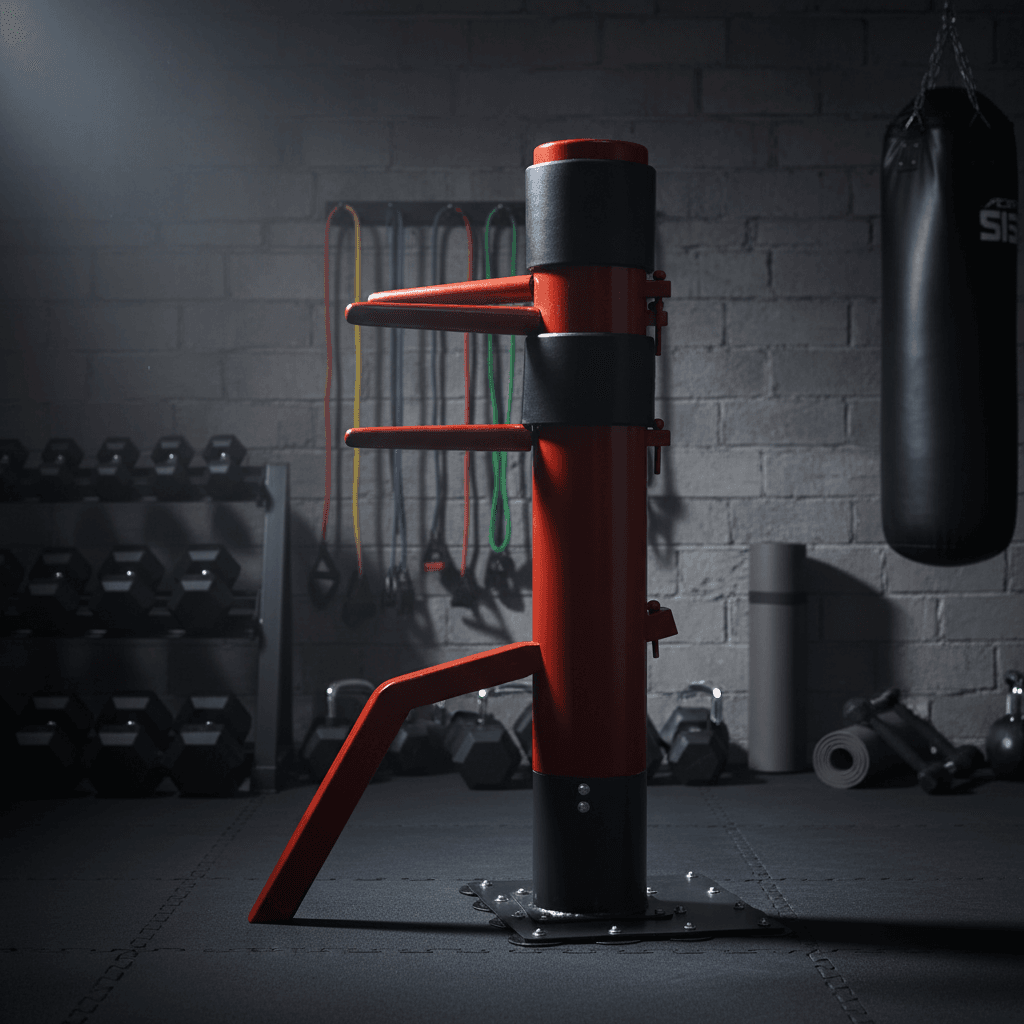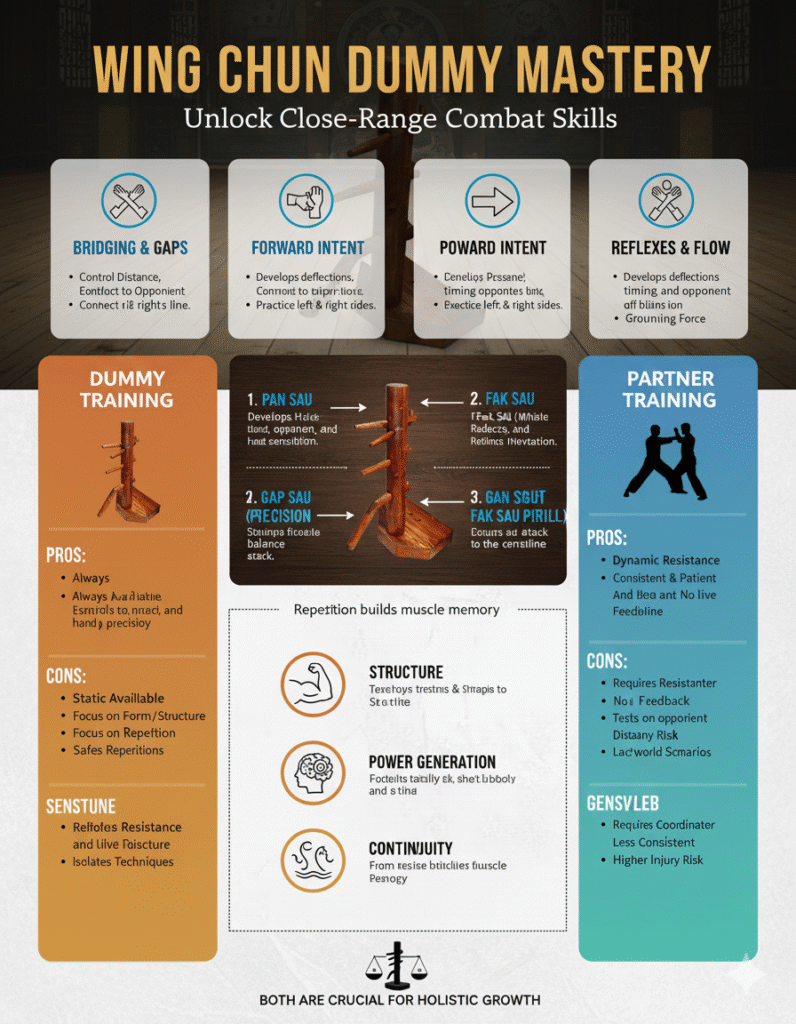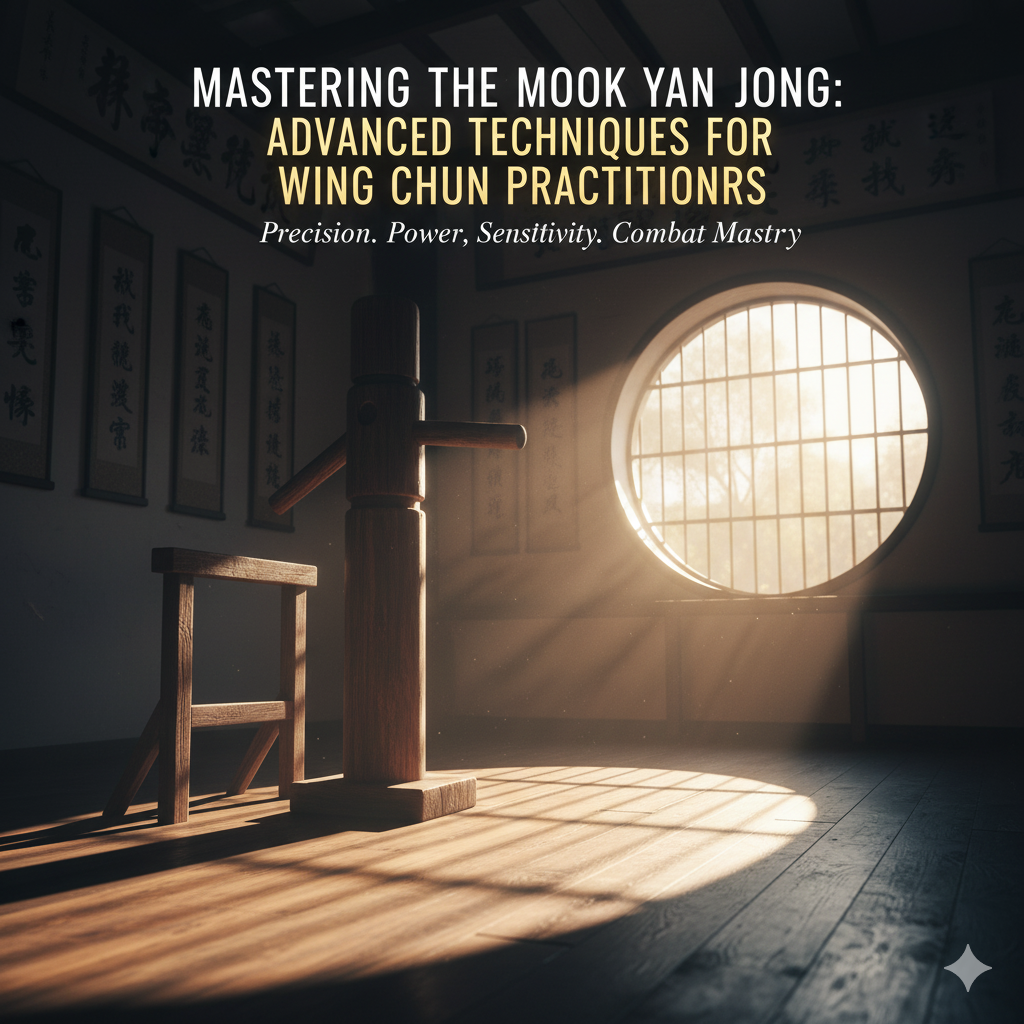As a martial artist, you’re constantly seeking ways to refine your skills, enhance your physical prowess, and ultimately, unlock your full potential.
The journey of martial arts mastery is a continuous pursuit of improvement, demanding dedication, discipline, and a holistic approach to training.
While traditional forms and techniques are fundamental, integrating specialized tools and conditioning methods can elevate your practice to new heights. In this blog post,
we’ll explore a powerful synergy: combining the ancient art of Wing Chun dummy training with modern conditioning workouts.
This integration isn’t just about adding more exercises to your routine;
it’s about creating a comprehensive training regimen that builds a more resilient, powerful, and effective martial artist.
The Unseen Advantages of Wing Chun Dummy Training
The Wing Chun wooden dummy, or Muk Yan Jong,
is more than just a training prop; it’s a silent partner that helps you internalize the core principles of Wing Chun.
My personal experience with the dummy has shown me its profound impact on developing crucial martial arts attributes.
It’s not merely about striking a wooden post;

it’s about refining your structure, enhancing your sensitivity, and building bone conditioning.
The dummy provides immediate feedback on your angles, balance, and force application,
allowing for precise adjustments that are difficult to achieve with a human partner alone.
One of the primary benefits is the development of proper structure.
When you engage with the dummy, you learn to maintain a strong, stable posture that allows for efficient force generation and absorption.
This structural integrity is vital in Wing Chun, ensuring that your energy flows directly through your body to your target, rather than dissipating.
The repetitive drills on the dummy engrain these structural principles into your muscle memory, making them second nature during live applications.
Furthermore, the dummy is instrumental in bone conditioning.
The constant impact, even when controlled, gradually strengthens your bones and connective tissues, preparing your limbs for the rigors of combat.
This isn’t about brute force; it’s about intelligent conditioning that builds resilience over time.
My arms, for instance, have become noticeably stronger and more resilient since I started consistently incorporating dummy training into my routine.
Finally, the dummy sharpens your sensitivity and develops your ability to feel and react to pressure.
As you flow through the forms, you learn to adapt to the dummy’s unyielding nature, developing a heightened sense of touch and an intuitive understanding of angles and leverage.
This sensitivity, often referred to as ‘listening hands,’ is a cornerstone of Wing Chun, allowing you to anticipate and neutralize an opponent’s movements with minimal effort.
Conditioning Workouts: Building a Martial Artist’s Physique
While the Wing Chun dummy refines your technical skills, conditioning workouts forge the physical attributes necessary to execute those techniques with power and endurance.
Martial arts demand a unique blend of strength, speed, agility, and stamina.
It’s not about building bulky muscles, but rather functional strength that translates directly into effective movements.
I’ve found that a well-rounded conditioning program complements martial arts training by enhancing explosiveness,
improving cardiovascular health, and increasing overall resilience.
When considering conditioning for martial artists, the focus shifts from isolated muscle groups to compound movements that mimic real-world combat scenarios.
Exercises like squats, deadlifts, and overhead presses build foundational strength, engaging multiple muscle groups simultaneously.
These movements are crucial for developing the power needed for strikes, throws, and grappling.
Personally, I’ve seen a significant improvement in my ability to generate force after incorporating these core lifts into my routine.
Beyond raw strength, agility and endurance are paramount.
Drills such as broad jumps, lateral bounds, and box jumps enhance explosive power and quick changes in direction, vital for footwork and evasive maneuvers.
High-intensity interval training (HIIT) and circuit training, incorporating exercises like burpees,
mountain climbers, and kettlebell swings, are excellent for building cardiovascular stamina,
allowing you to maintain intensity throughout prolonged engagements.
I often incorporate these into my training, pushing my limits to ensure I have the gas in the tank when it matters most.
Furthermore, flexibility and mobility are often overlooked but are critical for preventing injuries and maximizing range of motion.
Incorporating dynamic stretches, yoga, or even simple bodyweight movements can significantly improve your overall physical readiness.
A martial artist’s body is their most important tool, and just like any tool, it needs to be meticulously maintained and sharpened
The Synergy: Integrating Dummy Training and Conditioning
The true magic happens when you consciously integrate your Wing Chun dummy training with your conditioning workouts.
It’s not about doing one then the other in isolation;
it’s about creating a symbiotic relationship where each enhances the other.
I’ve found that approaching my training with this holistic mindset has accelerated my progress significantly.
The dummy work refines my technique and internalizes principles, while the conditioning provides the physical canvas upon which those techniques can be painted with power and precision.
One effective approach is to use your conditioning workouts to specifically address weaknesses identified during your dummy training.
For example, if you notice your stance wavering during certain dummy drills, focus on exercises that strengthen your core and leg stability, such as planks, lunges, and single-leg deadlifts.
If your punches lack snap, incorporate plyometric push-ups or medicine ball throws to develop explosive upper body power.
This targeted conditioning ensures that your physical development directly supports your technical mastery.
Conversely, the dummy can be used to apply the physical attributes gained from conditioning.
After a session of heavy squats, for instance, a few rounds on the dummy can help you translate that newfound leg strength into powerful, rooted stances and explosive forward energy.
The dummy becomes a dynamic testing ground for your conditioning, allowing you to feel how increased strength and endurance impact your techniques in a practical context.
It’s a feedback loop: conditioning improves your dummy work, and your dummy work highlights areas for further conditioning.
Consider structuring your training week to include dedicated days for dummy work, conditioning, and integrated sessions.
For example, you might have two days focused on Wing Chun forms and dummy drills, two days dedicated to strength and conditioning, and one day for a combined session where you actively apply your physical attributes to dummy techniques.
This varied approach prevents plateaus and keeps your training fresh and engaging.
Remember, consistency is key, and finding a schedule that you can adhere to is more important than any single workout plan.
Conclusion: A Holistic Path to Martial Arts Excellence
Integrating Wing Chun dummy training with conditioning workouts is not just a training methodology;
it’s a philosophy that embraces the interconnectedness of mind, body, and technique.
By systematically developing both your technical proficiency on the dummy and your physical attributes through targeted conditioning,
you create a holistic training regimen that propels you towards martial arts excellence.
This journey is personal, demanding introspection and consistent effort. But the rewards
—enhanced power, improved resilience, and a deeper understanding of your art—are immeasurable.
So, step onto your training floor with renewed purpose.
Engage with your Wing Chun dummy not just as a tool for technique, but as a mirror reflecting your physical capabilities.
Then, push your limits in your conditioning workouts, knowing that every rep and every set contributes to the power and precision you bring to your art.
Embrace this integrated approach, and watch as you transform into a more formidable, well-rounded, and truly masterful martial artist.
What are your experiences with integrating different aspects of your martial arts training?
Share your thoughts and tips in the comments below!



